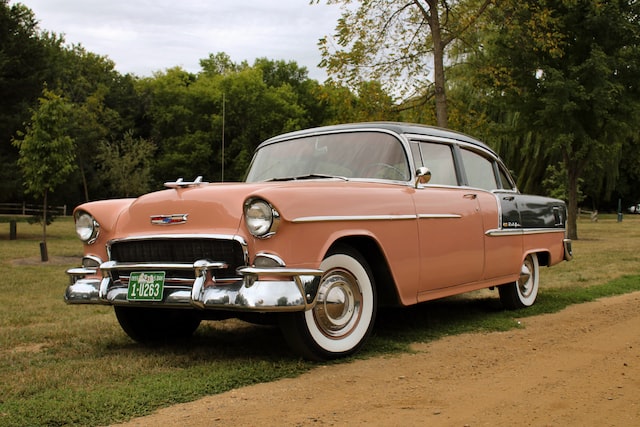Amaxophobia (from Ancient Greek “amaxos”) is a term illustrating the fear of driving. According to some studies, amaxophobia is more common than one might imagine, affecting around 33% of the population.
Many people hold the steering wheel when they are always obsessed with an action, object, or situation that could be dangerous. The fear of driving is a fatal drawback because it will keep you from getting where you need to go and can even interfere with jobs that require driving. If the anxiety behind the wheel takes control and prevents you from driving, it’s really important to face your fear so you can control the car with confidence. Here are a few of our suggestions about “How to get over the fear of driving?” that may be helpful to drivers, especially inexperienced drivers.
If you are planning to take a driver’s license, visit our website and try the free DMV practice test 2025 to get ready for it. Getting a thoroughly understanding also helps you be more confident to drive.
Where does your fear of driving come from?
Phobias and fears are often rooted in nature, although the fear of driving may not be the same. However, if you also have a phobia from your parents, it is very easy to pass it on to your children. Fear can arise from witnessing or experiencing something traumatic for yourself and then develop into avoidance of opportunities to do or compromise when faced with a frightening object or situation.
The anxiety with driving can develop gradually or very quickly and can stem from experiences or situations such as you are a witness or have been in a car accident; you used to scream or get very agitated when trying to learn to drive; you are the victim of a speed competition… Alternatively, the reason could be that you have taken on a dangerous journey that has had no accidents but can be quite scary, for example driving in the snow, on slippery ice, making driving extremely difficult. Finally, you get scared when you hear or read stories about bad traffic accidents.

How to get over fear of driving?
- Find ways to recognize your signs of fear
If you suffer from a phobia, you may experience a range of emotional to physical reactions, some mild, but some potentially debilitating. Responses from a phobia generally include:
- Stop taking action: you may never be able to drive again, or you may never want to learn to drive again.
- Emotional reactions: sweating, headache, lip biting, chest pain, heart palpitations, nausea, dry throat, feeling weak, legs shaking, dizziness…
- You feel the car lose balance, seem to be about to overturn when you turn a corner, or will slide off the road and fall into the cliff.
- You schedule too much and even longer than necessary, just to avoid scary roads, especially highways, or any intersections and areas with too many cars.
- You may become interested in arguing with someone who wants you to drive them somewhere instead of admitting that you’re nervous about driving.
- Braking too much when you don’t need to use the brake is also a common reaction from nervous drivers.
- Find advice and help
It’s really hard to get over a phobia, especially if you let it grow over time. But that dread can be easily dealt with, and if help is not sought, you may suffer needlessly. Your fear of driving can also make you vulnerable. See your doctor and discuss what you’re feeling. Your doctor may recommend that you follow a course of action, which includes seeing a therapist with “cognitive reprogramming”. The steps you can take will help you get over your obsession.
Talking about your fear is an important step because it’s the key to facing and accepting that you need to do something about it. Psychological measures vary from person to person. There are people who specialize in helping nervous drivers get back to driving and lessons are often held in safe places with the final exam often being the roads or places they fear the most.
- Avoid negative and complicated thoughts
Convincing yourself that sitting in a car will attract a car accident is a form of negative thinking. This usually happens after you’ve had an accident. Basically, you hypothesize that when you’re not in the car, you’ll avoid an accident, and when you’re in the car, you’re going to have an accident.
Accept that driving is inherently dangerous if you drive irresponsibly. On the contrary, let’s drive responsibly, always be on guard, and know your limits. Never drive after drinking alcohol. If you are tired, it is best to stop and rest to wait until you are fully awake to drive. But fatigue is no reason to never return to the wheel.
- Back to the steering wheel
If you haven’t driven in a while, it can be helpful to get back into the driver’s seat slowly, one step at a time. Get in the car and get used to everything again. Then take a short drive around the area you’re really familiar with. Gradually increase the time it takes to drive from home to another place. Take frequent breaks in between, like taking a 10-minute break every five-minute drive.
After a while, let’s drive to less familiar roads. Only do this when you believe you don’t need to rush home because you’re scared. Maybe ask someone to come with you if you’re back on highways or with heavy traffic, and drive slowly. Need to know where the exit from the freeway is in case you want to get out quickly.
- Make sure you do everything properly
Drive carefully and follow the speed limit. Driving carefully also means driving safely. It should be understood that driving is a common and everyday activity. You are a vigilant driver engaged in a joint operation with due care.
Do not go too fast and always run in the right lane if you want to go slower than other cars. No danger when changing lanes at the last second. If you miss a turn, you can go back to the previous section as long as it is safe to do so. You need to schedule from start to finish. Know where to go and when to change lanes to get out of the way. Basically, you need to be well prepared.
- Create safe driving habits
Check that the rearview mirrors are really straight and have the right viewing angles every time you sit in the driver’s seat. Adjust the chair for proper posture. Repair damaged parts as soon as possible. Just a broken rearview mirror or a damaged headlight can be dangerous.
Don’t let other drivers affect your psyche
Whether obeying the speed limit at all times or maintaining a steady speed with Cruise Control, you may encounter drivers who are always ready to cut through to squeeze into the space ahead of or follow closely behind. After that, flashing lights continuously force you to give way. Besides, there will always be other drivers impatiently running red lights, as if they are about to enter a speed race, as well as suddenly changing lanes without using a turn signal.
Advice from experienced psychologists and drivers
Above, all the typical concerns of new car drivers have been analyzed, which will help drivers self-adjust and calmly control the car. However, there are times when emergency situations arise on the road when you need to act quickly, relying only on your reactions and even the instincts acquired in the practical lessons.
- Create a calm environment in the car
You should feel comfortable every time you sit in the car regardless of whether the car is moving or not. Wear comfortable clothes and shoes. Practice sitting in the car and relax before you start driving. Consider playing soothing music. Music can help you overcome the feeling of panic that is rising and overpowering the traffic outside.
- Practice belly breathing
If you feel a panic attack or the muscles in your neck and chest become tight, take a deep breath into your lungs. Inhale slowly through the nose and focus on bringing the air deep into the lungs. Expand your abdomen as you inhale and hold your breath for a moment. Slowly exhale and relax your entire body.
- Apply Progressive Muscle Relaxation (PMR)
Tighten and release muscle groups in your body so that you are aware of how to hold and release tension. Start by holding your hands for 7-10 seconds. Open your hand for 15-20 seconds while focusing on feeling how the tension is leaving the hand muscles. You can practice PMR every day for 20 minutes without panicking. This technique can improve mood control, reduce the frequency of panic attacks, and enhance concentration.
- Practice saying positive statements
These are short affirmations to remind you that can make a change. For driving, the affirmations you should use are:
- I am driving carefully and within the speed limit. Careful driving is safe driving.
- Driving is a normal daily activity.
- I am a sober and careful driver.
- I don’t necessarily drive fast. I can drive in the right lane if I want to go slower than other cars.
- I planned the trip all the way. I have prepared well.
You should know that you are not the only one who feels scared every time you hold the wheel. Also, know that no one is perfect, but success at the wheel is possible. Everyone drives, so why can’t you? Hopefully, the above article on how to get over the fear of driving will help you in eliminating anxiety with driving.

UT Utah License Renewal: A 2025 Comprehensive Guide
Discover the ultimate guide to Utah license renewal! This comprehensive guide delves into the intricacies of renewing your driver's license in Utah,...
February 13, 2023

South Carolina S.C. Driver's License Renewal
The South Carolina S.C. driver's license renewal process is designed to be comprehensive, taking into consideration eligibility requirements, renewal methods,...
February 13, 2023

Pennsylvania PA DMV License Renewal: A 2025 Full Guide
The Pennsylvania PA DMV license renewal process is designed to be comprehensive, taking into consideration eligibility requirements, renewal methods,...
February 10, 2023

